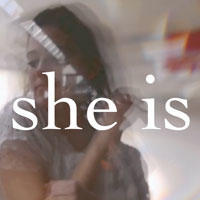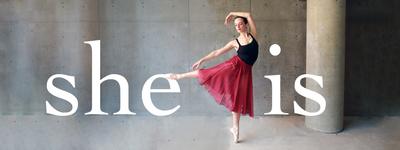 A new three-act choreography by Harvard Ballet Company looks to highlight the group as a creative space for womxn voices. The result – she is – opens this week at Farkas Hall.
A new three-act choreography by Harvard Ballet Company looks to highlight the group as a creative space for womxn voices. The result – she is – opens this week at Farkas Hall.
By Truelian Lee '21
Harvard Ballet Company directors Margaret Canady ’20 and Isabel Wu ’20 had just put their laptops away. They were a striking pair – Canady in a periwinkle button down and a brightly patterned maxi skirt, and Wu in a denim jacket and black sneakers. They were sitting at one of the small wooden tables in Café Gato Rojo. Canady and Wu had been discussing logistics for she is, the company’s fall production running Oct. 18-20 at Farkas Hall. When they realized I had arrived, they shifted in their chairs to make room for a third person at the table, and we talked about the production.
We began discussing the origins of she is, but Canady and Wu could not pinpoint a definite beginning. They described a process that blossomed organically, almost serendipitously.
“We had to pitch something last semester, and we wanted to make something was meaningful to our dancers and that people will connect to,” Canady said. “It’s rare to have such a strong group of women supporting each other in the dance world. It’s a very competitive environment, and the majority of people in director and choreographer positions are men. But the majority of our choreographers and our board members are womxn, and we thought we should celebrate this.”
Wu agreed, describing the show as a way to “not take it for granted that we have a strong community of womxn in the company.”
company.”
“It kind of evolved from there,” Wu said. “We realized in the past three shows, we haven’t used a single womxn composer or musician, so we decided to do so.”
“We wanted to highlight that the ballet company is a creative space for womxn voices,” Canady added.
Canady and Wu had envisioned a show in the triple bill format, with three acts. The first focuses on the process of emerging into womxnhood. The second is about the challenges womxn face in contemporary society. And the third is a celebration of womxnhood. They opened an application for company members to propose choreography that would address an aspect of womxnhood and then grouped these into three acts. Both Canady and Wu are choreographing and dancing in the show.
“It’s really amazing seeing the show come together and work with choreographers from the very beginning and creating this show from the ground up,” Canady said. “We have a very diverse dance style. Choreographers pick an idea they resonate with and they are interested in very different types of movement.”
For example, she told me about a choreographer’s piece on female friendship in which dancers move in synchronicity and do duet work to represent friendship and unity. Canady also described her choreography, which is centered on body image and uses "trust falls" to represent supporting and trusting one another through difficult times. In Wu’s balletic piece, "younger" dancers watch and then mimic "older" dancers – a vision of how mentorship has an impact on development.
Canady described the range of choreography from pointe pieces and classical scores to modern dance and electronic pop.
This is Canady’s and Wu’s second semester directing, and both said that their experiences directing in addition to choreographing and dancing have encouraged them to grow as artists.
“Directing and choreographing has allowed me to bridge the gap between the artistic and the logistic – learning how to balance a show’s vision with all the little bits and pieces that go into it,” Wu said.
“I think it’s really amazing to be building the show from the ground up, coming up with an idea and then working with choreographers and dancers and seeing how our company brings it to life,” Canady said. “We are in a position of power to put on this show on campus and to have people come see it and to be part of a topic of conversation, and we wanted to make it count.”